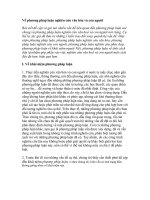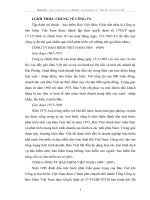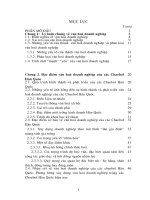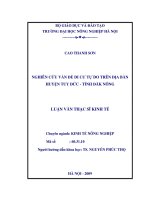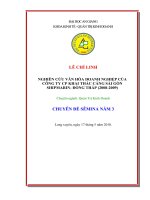Nghiên cứu văn hóa về cử chỉ chào hỏi việt anh
Bạn đang xem bản rút gọn của tài liệu. Xem và tải ngay bản đầy đủ của tài liệu tại đây (2.37 MB, 93 trang )
VIETNAM NATIONAL UNIVERSITY, HANOI
DEPARTMENT OF POSTGRADUATE STUDIES
Bùi Thị Thu Thủy
A VIETNAMESE-ENGLISH CROSS-CULTURAL
STUDY ON GESTURES FOR GREETING
nghiªn cøu giao v¨n hãa vÒ cö chØ
chµo hái viÖt - anh
Field : English linguistics
Code : 50409
Course : K11. MA. Minor Thesis
Supervisor: Assoc. Prof, Dr. Nguyen Quang
Haiphong, July 2005
Acknowledgements
I would like to express my special thanks to my supervisor, Assoc. Prof., Dr. Nguyen
Quang (Foreign Languages College, VNU- Hanoi) for his invaluable guidance and
instructive comments throughout this study.
I am greatly indebted to my teachers (Foreign Languages College, VNU- Hanoi,
Department of Post Graduate Studies), especially Dr Nguyen Van Chien (Institute for
Southeast Asean Studies) for their lectures on the area of valuable knowledge which
enlightened the arguments in the study.
I also wish to acknowledge my friend, Nguyen Quoc Sinh for his helpful suggestions and
constructive ideas, which have been useful for the accomplishment of the paper.
I also wish to thank my student, Tran Thi Thien Thanh for her encouragement and
valuable help.
My acknowlegement goes to the informants, Vietnamese and English native speakers, who
spent their precious time completing the questionnaires.
Finally, and the most, I owe my deep thanks to my parents and my husband, who gave me
constant support and enormous encouragement throughout my M.A.course.
Haiphong, July 2005
Bui Thi Thu Thuy
Table of contents
Acknowledgements
List of tables
Page
Part A: INTRODUCTION 1
1. Rationale 1
2. Aims of the study 2
3. Research questions 2
4. Scope of the study 2
5. Methods of the study 3
6. Comments on the survey questionnaires 3
7. Comments on the informants 4
8. Design of the study 6
Part B: DEVELOPMENT 7
Chapter 1 Theoretical background 7
1.1 Communication and cross-cultural communication 7
1.1.1. Communication and nonverbal communication 7
1.1.2. Nonverbal communicative competence 8
1.1.3. Cross-cultural communication 8
1.2. Gestures 9
1.2.1. Gestures defined 9
1.2.2. Gestures classified 10
1.2.3. Gestures across cultures 11
Chapter 2 Greeting gestures 14
2.1. Greetings 14
2.2. Greeting gestures across cultures 15
2.2.1 Some dead gestures 15
2.2.2. Contemporary greeting gestures 15
2.2.2.1. Handshaking 15
2.2.2.2. Hugging / Embracing 19
2.2.2.3. Waving 19
2.2.2.4. The High five 20
2.2.2.5. The Bow 20
2.2.2.6. Nodding 21
2.2.2.7. The Pat 22
2.2.2.8. Raising eyebrows 22
Chapter 3 : Data Analysis and Findings 23
3.1. Greeting gestures as perceived by the Vietnamese informants 23
3.1.1. Data analysis of greeting gestures 23
3.1.2. Considerations of factors affecting greeting gestures 27
3.1.3. Data analysis of handshaking gesture 27
3.2. Greeting gestures as perceived by Anglicist informants 29
3.2.1. Data analysis of greeting gestures 29
3.2.2. Considerations of factors affecting greeting gestures 33
3.2.3. Data analysis of handshaking gesture 34
3.3. Major cross-cultural similarities and differences 34
Part 3: Conclusion 37
1. Summary 37
2. Suggestions for avoidance of culture shock and communication 37
breakdown
3. Suggestions for further research. 38
List of tables
Table 1: Informants' background
Table 2: The use of greeting gestures ( for both the Vietnamese and English native
speakers)
Table 3: Greeting gestures most frequently used by the Vietnamese
Table 4: Frequency of greeting gestures in use (Vietnamese subjects)
Table 5: Greeting gestures in terms of age (Vietnamese subjects)
Table 6: Greeting gestures in terms of gender (Vietnamese subjects)
Table 7: Greeting gestures in terms of Marital status (Vietnamese subjects)
Table 8: Greeting gestures in terms of Social status (Vietnamese subjects)
Table 9: Greeting gestures in terms of communicative environment (Vietnamese subjects)
Table 10: Factors affecting greeting gestures (Vietnamese subjects)
Table 11: Handshaking in certain situations (Vietnamese subjects)
Table 12: Handshaking in terms of gender (Vietnamese males)
Table 13: Handshaking in terms of gender (Vietnamese females)
Table 14: Handshaking in terms of age (20 < X < 40)
Table 15: Handshaking in terms of age ( X ≥ 40)
Table 16: Greeting gestures most frequently used by English native speakers
Table 17: Frequency of greeting gestures in use (Anglicist subjects)
Table 18: Greeting gestures in terms of age (Anglicist subjects)
Table 19: Greeting gestures in terms of gender (Anglicist subjects)
Table 20: Greeting gestures in terms of Marital status (Anglicist subjects)
Table 21: Greeting gestures in terms of Social status (Anglicist subjects)
Table 22: Greeting gestures in terms of communicative environment (Anglicist subjects)
Table 23: Factors affecting greeting gestures (Anglicist subjects)
Table 24: Handshaking in certain situations (Anglicist subjects)
Table 25: Handshaking in terms of gender (Anglicist males)
Table 26: Handshaking in terms of gender (Anglicist females)
Table 27: Handshaking in terms of age (20 < X < 40)
Table 28: Handshaking in terms of age ( X ≥ 40)
Table 29: Greeting gestures used most frequently by the Vietnamese and English native
speakers
Table 30: Factors affecting greeting gestures ( Vietnamese and Anglicist subjects)
PART A - INTRODUCTION
1. Rationale
Language is an important part of our functional activity and we indicate, often in
diagrammatic form, the varying communication patterns used in meetings and during
negotiations. Language studies have traditionally emphasized verbal and written language,
but recently have begun to consider communication that takes place without words. In
some types of communication people express more nonverbally than verbally, for example,
in expressing human emotions and attitudes. Nonverbal communication including gestures,
postures, facial expressions, touching behaviors, vocal behaviors, etc. is said to convey
anything up to 90 percent of our message, and plays an important role in our daily life.
Along the line of reasoning, nonverbal communication appears even more powerful than
the verbal interaction. Thus, it is essential that study on nonverbal communication be paid
more attention to.
Gestures are found fascinating things, at once wholly expressive and curiously mysterious.
The flick of the wrist, the wave of a finger, or simply the movement of an eyelid can say
more than a speech, and sometimes a subtle gesture can express a feeling more gracefully
than words. (Armstrong & Wagner, 2003:1). Gestures used for greetings, in particular,
play an important part in communication in that they help to establish and maintain a
relationship in an initial meeting.
In Vietnam in the last few years, ELT has concentrated on communication with
emphasis much on communicative competence rather than on simply linguistic
competence. As Vietnam has adopted an open-door policy, the number of people
who wish to master English for international communication and further study
overseas is increasing. However, it is observed that ELT in Vietnam, as a matter of
fact, has focused too much on the verbal aspects of communication (which is
necessary but not sufficient) while ignoring nonverbal communicative competence.
Consequently, learners fail to communicate effectively across cultures due to the
misinterpretations of nonverbal cues extended by native speakers.
Therefore, with an effort to rise awareness of both teachers and learners about the
importance of nonverbal communication, to improve learners’ communicative
competence, to help them communicate effectively in initial meetings and avoid culture
shock in cross- cultural communication “A Vietnamese-English Cross-Cultural Study on
Gestures for Greeting” is chosen as the topic for my study.
2. Aims of the study
The aims of the thesis are:
• To study different kinds of gestures for greeting with illustrations
• To analyze some greeting gestures that causes misinterpretations,
misunderstandings and culture shock in English - Vietnamese cross-cultural
communication.
• To raise potential cross-cultural interactants’ awareness of the differences in
English-Vietnamese nonverbal communication in general and the use of gestures
for greetings in particular.
3. Research questions
• What is the greeting gestures commonly used by English native speakers?
• What is the greeting gestures commonly used by the Vietnamese?
• What are the potential areas of culture shock in nonverbal greetings?
4. Scope of the study
Gesture is a large aspect of nonverbal communication. According to its functions it is
divided into such categories as Greeting/ Parting, Approval/ Disapproval, Offensive and
Profane, Just for Emphasis, etc. In this study, attention will be focused on some gestures
for greeting, which are commonly used in initial meetings. They are handshaking,
nodding, waving, hugging, high-5, patting on one's shoulder/ back, bowing, wai and
raising eyebrows. Of the nine gestures, priority is given to handshaking as it is most
frequently resorted to in all cases while we carry out the survey and analyze the data.
Smile is also a very popular gesture of greeting, however, due to the limitation of a minor
thesis, it is not mentioned in the paper.
Furthermore, in the pilot survey questionnaires it is found that such parameters as
occupation and area of living appear almost constant in all situations. Thus, I have decided
to ignore them and focus only on age and gender while analyzing data. Major similarities
and differences between the English and Vietnamese native speakers when performing
gestures will also be highlighted and analyzed in great detail to avoid misinterpretations,
misunderstandings and culture shock in Cross – Cultural Communication and help to
perform an effective communication as well.
5. Methods of the study
To achieve the aims stated, a microlinguistic contrastive analysis (CA) is carried out
throughout the study.
Since this study dwells largely on the practical aspects of cross-cultural communication,
the main method employed is quantitative. All the considerations and conclusions are
largely based on the analysis of the statistic data and references. The major approaches
are:
- Reference to publications
- Survey questionnaires
- Discussions with foreigners, overseas students, employees from foreign companies
and their Vietnamese counterparts
- Discussions with supervisor
- Personal observations
6. Comments on the survey questionnaires
The survey questionnaire consists of seven questions in six of which the informants are
requested to tick (√) where they think appropriate for using greeting gestures. The most
nine common gestures are given: handshaking, waving, high-five, hugging, patting on
shoulder / back, nodding,bowing, raising eyebrows and wai.
In addition, the informants are asked to tick the parameters chosen among age, gender,
occupation, marital status, social status, length of time they have known each other, and
environment, which they generally take into consideration when greeting someone and
rank them in a level scale of importance.
The informants are also required to show their own greeting gestures when meeting
people of old age, same age and young age; same sex and different sex; higher, equal and
lower status; in different environments.
The seventh question seen as the DCT questionnaire focuses on the ways of handshaking,
which is found the most common of nine gestures given. The informants are requested to
express how they shake hands when meeting the followings:
− Those who are their close friends
− Those who are persons they dislike
− Those who are their colleagues of the same age / same sex
− Those who are their colleagues of the same age / opposite sex
− Those who are their acquaintances who are 10 years older than the informants
− Those who are their acquaintances who are 5 years older than the informants
− Those who are their brother / sister
− Those who are their uncle / aunt
− Those who are their boss of 10 years older / 5 years younger
7. Comments on the informants
Of 75 questionnaires delivered to the Vietnamese who live in the North of Vietnam, 50
copies are selected for comparison and analysis together with 50 copies out of 55 returned
by the English native speakers who are living and working in Australia. As the English
survey questionnaires were administered in Melbourn, Australia, the majority of
informants are Australians and the rest are British, American, New Zealand, and Canadian
people.
It is essential that certain knowledge of the informants' background be discussed for the
analysis of the data. Thus, the following parameters are taken into account:
- Nationality
- Age
- Sex
- Marital status
- Area where informants spend most of their time
- Occupation
- Social relation
- Personality
The author is well aware that the two last parameters are of great importance but
inaccessible, therefore they are not included in the questionnaires. (See the data of the
parameters in Table 1)
Table 1: Informants' background
Informants' parameters Vietnamese
(N= 50)
Anglicist
(N= 50)
Male
(N=33)
Female
(N=17)
Male
(
N
=
3
3
)
Female
(N=17)
Informants below 20 1 0 8 0
Informants above 20 12 6 13 5
Informants above 30 5 3 1 3
Informants above 40 8 4 4 1
Informants above 50 6 4 5 8
Informants above 60 1 0 2 0
Informants who are married 22 11 8 8
Informants who are single 11 6 25 9
Informants who spend most of
their time in urban areas
27 15 26 12
Informants who spend most of
their time in rural areas
6 2 7 5
8. Design of the study
The paper consists of three parts.
Part A, Introduction, covers rationale, aims, research questions, scope, methods,
comments on the questionnaires, comments on the informants, and design of the study.
Part B, Development, is composed of three chapters:
+ Chapter one, Theoretical background, provides theoretical discussions to background
the topic in focus.
+ Chapter two, Greeting gestures, presents comments on gestures for greeting: definition,
significance and classification with focus on handshaking.
+ Chapter three, Data analysis and findings, analyses greeting gestures perceived by the
Vietnamese and English native speakers, as well as the ways of handshaking in certain
situations, discusses findings on similarities and differences, especially areas of potential
culture shock between the two cultures in cross- cultural communication.
Part C, Conclusion, offers the overview of major findings and suggestions for avoidance
of culture shock and communication breakdown among Vietnamese-English cross-
cultural interactants.
PART B - DEVELOPMENT
Chapter 1 Theoretical background
As named, this chapter will review the theories of communication and nonverbal
communication in some researchers' points of view and its importance in human
interaction. Various definitions about gestures as well as categories are illustratedly
introduced in this chapter.
1.1 Communication and cross-cultural communication
1.1.1 Communication and nonverbal communication
Overall, human communication is the process of creating and sharing meaning and is
defined as the exchange of ideas, information, feelings, etc. between two or more persons
(Richards et al. 1992:64) and “That process involves not only the spoken and written
word, but also body language, personal mannerisms and style, the surroundings-anything
that adds meaning to a message” (Hybells and Weaver II, 1992 : 4).
Commonly used, the term communication refers to information sharing. First, a message
forms within us. Then we send that message which stimulates meaning in the mind of
another person. An individual takes something in -something said or done- and by some
internal process he or she then attaches meaning to what is taken in. When communication
occurs inside a single person, the sharing of thoughts and feelings with the self is called
intrapersonal; between two or more persons, communication is interpersonal.
Hybells and Weaver (1992:7) also assume that ideas and feelings that make up the message
can be communicated only if they are represented by symbols that stand for something
else. All our communication messages are made up of two kinds of symbols: verbal and
nonverbal. Verbal symbols are limited and complicated. They include concrete symbols
that stand for a particular thing such as chair and abstract symbols such as hungry or hurt.
Nonverbal symbols are anything we communicate without using words such as facial
expressions, gestures, posture, vocal tones, appearance, and so on. As with verbal symbols,
we all attach certain meanings to nonverbal symbols. A yawn means we are bored or tired;
a head nodding indicates agreement or greeting; not looking someone in the eye may mean
we have something to hide, etc. Whether or not we are aware of them, nonverbal symbols
are extremely important to messages. Some communication scholars believe that over 90
percent of the messages we send and receive are made up of nonverbal symbols.
As a matter of fact, nonverbal communication uses nonverbal symbols or, in other words,
nonverbal cues. Nonverbal communication differs from verbal in that it concerns itself
with the entire range and scope of communication over and above the use of words. In
other words, whatever the message, the channel, or the nature of intensity, of intentionality
- where words are not evolved, the communication is nonverbal. Knapp & Hall (1997:13-
18) have identified the following functions of nonverbal communication as (i) repeating
what is said verbally,(ii) contradicting verbal messages, (iii) complementing a verbal
message, (iv) regulating verbal communication, (v) subtituting for verbal messages, and
(vi) often accenting / moderating what we are saying.
From all mentioned above it can be concluded that nonverbal communication, the
information we communicate without using words, is extremely important in human
interaction.
1.1.2. Nonverbal communicative competence
Communicative competence is known as the ability not only to apply the grammatical
rules of a language in order to form grammatically correct sentences but also to know
when and where to use these sentences and how communicate and with whom. In other
words, communicative competence needs linguistic knowledge, interaction skills and
cultural knowledge as well. It is clear that when someone wishes to communicate with
others, they must recognize the social settings, their relationship to the other(s), and the
types of language that can be used for a particular occasion.
Nonverbal communicative competence is understood as the ability to use nonverbal cues
effectively. As mentioned above, over 90 percent of the message is transmitted by nonverbal
language (e.g. gestures, facial expressions), therefore, a good communicator is supposed to
know what nonverbal cues are appropriate to use, in which context and how. S/he needs to
take her/ his partners' age, gender, social status, the setting where the communication takes
place, etc. into consideration in order to produce effective communication. Besides, cultural
and cross-cultural factors should be paid much attention to so that misinterpretations,
misunderstandings and communication breakdown can be avoided.
1.1.3. Cross-cultural communication
Culture can be defined as the total set of beliefs, attitudes, customs, behavior, social
habits, etc. of the members of a particular society. (Richards et al. 1997: 94). Therefore,
culture is community- specific. It has its own sets of values that help distinguish one
community from another. When people from different cultural backgrounds meet each
other they need to exchange ideas, information etc., between them, which is called cross-
cultural communication. Normally, people know how to behave appropriately within their
own culture and community but when they move to another, this social etiquette changes.
It is realized that there are often more problems in cross-cultural communication than in
communication between people of the same cultural background. Each participant may
interpret the other's speech or behavior according to his or her own cultural conventions
and expectations. Thus, if the cultural conventions of the participants are widely different,
misinterpretations and misunderstandings can easily arise, even resulting in a total
breakdown of communication. Consider the following example:
Two engineers, one from America, and the other from Germany, worked together in the
program of exchanging engineers for purposes of product familiarization. One day, at
work, to compliment the German colleague on his new idea, the American made a circle
with his thumb and forefinger, a sign used throughout North America to mean "O.K." The
German abruptly put down his tools and walked away. He refused any further
communication with the American. Finally, it was discovered that, to a German, when
someone forms a thumb and forefinger in a circle, as the American had done, it signifies
“You asshole.”(Axtell, 1998)
1.2. Gestures
1.2.1. Gestures defined
There have been a number of definitions about gestures given by researchers and scholars.
Hybells and Weaver II (1988:345) state that, gestures are made up of hands and arm
movements. Sharing the same idea, Verderber (1990:87) claims that gestures are
movements of hands, arms and fingers which are used to describe or intensify something.
However, some researchers argue that gestures are the use of hands, arms, head and legs
(Carr, 1998: 78), or gestures are movements of the face or body which communicate
meaning (Richards, 1992: 157), for example: nodding the head can be understood as
agreement, tapping feet, drumming fingers may indicate boredom or nervousness, avoiding
a look may be interpreted either as dishonesty or as shyness.
In "Nonverbal communication across cultures" (Forthcoming:163) Nguyen Quang
provides a full definition of gestures as follows:
Gestures can be understood as the movements of arms, legs and body which are
used independently or with words in communication in order to emphasize or
replace words, to control or display one's feelings and attitudes, and to express
one's thought.
In brief, gestures perform many functions which may replace speech (during dialogue or
when speech is not used at all), regulate the flow and rhythm of interaction, maintain
attention, add emphasis and /or classify to speech, help characterize and memorize the
content of the speech.
1.2.2. Gestures classified
Gestures have been classified differently by researchers in the way of gesture origin,
functions, or parts of the body. Axtell (1998: 4) divides human actions and gestures into
three broad categories: instinctive, coded and acquired.
Instinctive gestures are those we do almost unconsciously. For example, we may slap our
own forehead with the heel of the hand (Figure 1) when we forget something or remember
something. The performance of this gesture may illustrate that we have said or done
something silly and inappropriate. Another common instinctive gesture is when one
crosses one's arm in front of the chest, which is a signal of defensiveness or, on the other
hand, perhaps the person is merely chilly (see Figure 2).
Figure 1: A slap on head Figure 2: An arm crossing
Coded, or technical, gestures are created by pre-established agreement. The best-known
coded language today is the Sign Language for the Deaf-Mute (see Figure 3)
Figure 3. American Sign Language
Acquired gestures, according to Axtell, are socially generated and many of them have no
known origins (e.g., the "O.K." sign) or no reason (e.g., the hand waving, as in hello and
good bye).
Figure 4: the O.K. sign Figure 5: the Waving
Acquired gestures seem to be loosely and informally collected among seperate societies
with no particular logic except that they are widely used and understood among a certain
group of people (Axtell, 1998:5). Taking this sense into consideration, acquired gestures
convey many meanings and differ across cultures, which are accepted in one society but
considered very rude or even insulting in other. The nature of these is the main subject of
discussion in the following section.
1.2.3. Gestures across cultures
There are no universal gestures. As far as we know, there is no single facial
expressions, stance or body position which conveys the same meaning in all
societies.
R. L. Birdwhistell
(cited from Knapp & Hall, 1997: 43)
Identical / acquired gestures, as have been previously discussed, are community- specific.
They often mean different things among different societies. For instance, the Thumbs-up
can be seen as a gesture of approval, which is widespread, commonly practiced in North
America and most of Europe and also seen in other parts of the world as an imported
Western gesture (see figure 7). In the U.S., Britain, Australia the thumbs-up gesture
commonly used by hitch-hikers who are thumbing for a ride and it is also an O.K. signal.
However, it should be cautious about using this gesture in Nigeria as it is considered a very
rude and insulting signal. Lack of awareness of this easily leads to misunderstandings,
communication breakdowns, and even culture shock among people from different cultures.
Figure 6: The Thumbs-up Figure 7: The Thumbs-up as a general
meaning of "good" or " positive "
Victory or "V " sign (see figure 8), performed by holding two fingers upright to signal
"victory" or "peace", is also a very popular gesture in most parts of the world. Its origin
started in World War II, followed by the Peace Movement of the 1960s. Politicians can
often be seen flashing this gesture at political rallies, signifying their belief that their
candidates will win. The "V" gesture is perhaps the only gesture that unites politicians and
protestors (see figure 10). However, the "V" gesture has multiple meanings that depend on
whether the palm faces away from or toward the body. The "V" gesture with the palm out
has positive meaning as mentioned above, but with the palm in, the "V" gesture, which
translates roughly to mean "Up yours!" used to insult other(s) (see Figure9).
Figure 10: Former Texax governor Ann
Richards makes the "V for victory" gesture
during her political campaign in 1990
Figure 8: the "V" (with palm out) Figure 9: the V (with palm in)
Similarly, the "Horns", or "Hook 'em Horns" gesture, has different meanings (both positive
and negative) in different areas in the world. It is shown by the index and pinkie fingers
extended from a fist and the gesture resembles a horned animal. From its origin, the horns
are used primarily in southern Europe and near Mediterranean, especially in Spain,
Portugal, and Malta to mean that a wife is cheating on a husband. Therefore, in such places
if one is shown this gesture by his friends, neighbours or colleagues, he must feel insulted
and furious as he is signaled that his spouse is being unfaithful (see Figure 11)
In Italy and Malta, on the other hand, the gesture also hangs on as a symbol to keep away
from evils and bad luck. In the United States, the United Kingdom, and other countries
where hard rock made its indelible mark, it is seen as a rock 'n' roll symbol. For thousands
of avid Texas football fan, on the other hand, this is the time-honoured rallying gesture for
the University of Texas Longhorns football. (see Figure 12)
Figure 11: "You are being cuckolded " Figure 12: The University of Texas
The sign for O.K. (see Figure 4) in Anglicist culture is interpreted good/ well-done, but in
Japanese: money; in France: zero; and in some Mediterranean countries: a gay man.
In brief, there are millions of gestures in the world and even more interpretations. From
these examples it is undeniable that cultural misinterpretations of gestures can produce
embarrassing results and that one's cultural background should always be considered
before coming to conclusions about his or her gestures. Within this study we will focus on
gestures for greeting to find out the significance of greeting gestures as well as their
distinguishing usage across cultures. The nature and extent of this diversity will be made
clearer in the following chapter.
baseball team making the "Hook 'Horns "
gesture during their victory celebration at a
college World Series.
Chapter 2 GREETING GESTURES
2.1. Greetings
According to Goody (1972:40), greetings have three major functions: (1) to open a
sequence of communicative acts between two persons, irrespective of their positions; (2)
as a means of defining, and affirming, both identity and rank; (3) a mode of deference
upon or manipulating a relationship in order to achieve a specific result.
Similarly, Tillit (1989) and his colleagues, in the introduction to his speaking course, also
give such ideas on the purpose of greetings as followings: to establish contact with another
person; to recognize his or her existence, and last but not least, to show friendlineness.
In brief, greetings, in almost every language, obviously help to establish and maintain a
relationship in an initial meeting and to facilitate the conversation. People, while meeting
one another, perform greetings verbally, verbally and nonverbally, or just only
nonverbally. It is commonly seen somewhere people say “Hello” or “Hi”, “How are you?”,
smiling brightly or nodding slightly. However, a waving from distance when people are in
a hurry, a handshaking, a nodding seem to be popular gestures while people greet each
other, as gestures can say more than a speech, and sometimes a subtle gesture can express a
feeling more gracefully than words.
Take a handshake between Palestinian leader
Yasir Arafat and Israeli Prime Minister
Yitzak Rabin as an example. Via international
television, the world observed that a simple
handshake was the subject of great
deliberation and discussion between two
leaders and U.S. president Bill Clinton.
Figure 12: Rabin and Arafat shaking hand
According to a survey it appears that greeting gestures are initially used whenever
communicative situations take place. In the following section we are introducing a variety
of greeting gestures some of which are dead, and many seem to vary from culture to
culture in use. However, to the extent of the study, only some popular greeting gestures are
looked into.
2.2. Greeting gestures
2.2.1 Dead gestures
Throughout the human history hundreds of gestures including greeting ones disappeared
and hundreds are found new. This is mainly because there have been changes in social and
industrial development and partly due to the extinction of ethnic minorities and some
tribes. A visible dead gesture is “koutou”(an old Chinese gesture used when someone met
the emperor), which is described as followed: (i) right sleeve brushing the left arm from
top to the fingers; (ii) left sleeve brushing the right arm from top to the fingers; (iii) bend
down, one knee on the floor, right hand on the back and left hand hitting the floor.
Figure 13: The Koutou (i) (ii) (iii)
The Vietnamese greeting gestures 'hand clasping' and 'arm folding' with body bending
commonly used by people of low class when meeting someone richer and in a higher
position are hardly found nowadays. Similarly, "tip hat" with body bending and "hand
kissing " are no longer popular in Western countries.
2.2.2. Contemporary greeting gestures
There are hundreds of estimated contemporary gestures of greeting from East to West,
however, here we consider the nine more familiar and common ones:
2.2.2.1. Handshaking
There is a Western saying: “The Gods hear men's hands before their lips”. This indicates
the great significance of nonverbal communication in general and hand gestures including
handshaking in particular. A handshake and the ways of shaking hands can provide you
with as much information about your interactant as a psychological profile. This is because
the body cannot lie no matter how much a person may try to cover up his/ her true
intentions. Thus, you can discover whether s/he is warm or cold, friendly or unfriendly,
sincere or insincere, trustworthy or deceitful, dominant or submissive, etc.
Beisler (1997:194), in his study on handshaking and its interpreted messages states
“Shaking hands often gives an immediate clue to a person's attitude to the encounter.
There are multiple variations of hand shaking, involving the angle at which the hand is
held, the force of the grip, how long it lasts, the number of shakes, the use of two hands,
the direction of the force, and the distance between the people.”
Ways of shaking hands depend on many factors, the more common and typical of which
are relationship between interactants, environment and culture. Generally, how people
shake hands is categorized depending on three followings:
- ways of giving hands to shake (e.g.: palm-up , palm -down , )
- way of grasping interactant's hand(s) ( e.g. : firm , weak, gentle, )
- length of handshaking time
Though handshaking is considered as a universal greeting gesture there has been a variety
of handshakes from different points of view. According to Nguyen Quang (The
forthcoming), there are 12 basic types of handshakes :
The All - American (Figure 15) :
This is the handshake used by most leaders,
politicians, and corporate executives. The
person delivering it will look you right in the
eye, fully engage your hand, smile and pump
your hand two or three times. This handshake expresses a feeling of self confidence. The
person using it will be open, trust worthy and willing to listen
The Lingering Handshake (Figure 16):
This one is firm with a warm grasp and two
more pumps. The end of the handshake
pauses or lingers. The lingering quality may
denote openess and sincerity, or it may
suggest that the person has something up his/ her sleeve. This kind of hand shaking seems
to be very popular in Vietnam and some South-Eastern countries.
The Push-Off / The Stiff -Arm Thrust (Figure 17):
This one may refer to a firm and warm grisp, but at the
end your hand is pushed or flicked away. The Push-Off
can range from a slight stiff-arm to a flat-out rejection.
According to Nguyen Quang (2005: 225) this handshake
may imply such implications as (i) the person has a
strong need to establish his or her own territory and agenda; (ii) he/ she does not want to
appear friendly and close to the other; (iii) he/ she belongs to low-touch group/ sub-
culture/ culture.
The Pull-In / The Arm Pull (Figure18):
This is a somewhat manipulate handshake. This person
holds on to your hand to pull you closer or direct you
through a door or towards a chair. Thus, this handshake
reflects his willingness to be close and friendly to the
other. Besides, he may belong to high-touch group/
sub-culture/ culture.
The Two-Handed Shake / The Double-Handed Shake (Figure19) :
This one normally used to imply sincerity, intimacy and deep friendship to receiver. There
are different thoughts on this handshake between Western and Vietnamese cultures. It is
observed that whereas the Vietnamese prefer giving the double-handed shake only to
person of older age or higher social status, the Western are
likely to person of even younger or lower social status. To
one who is older or ranks higher the Euro-American use
one hand only. This because in Vietnamese culture, this
kind of handshake implies the respect to other while it does
not in Western cultures except for sincerity and intimacy.
Nguyen Quang (Forthcoming), divides this handshake into four categories : the Shake-and-
Cover, the Glove Handshake, the Shake-and-Support, the Shake -and-Grip.The first two
are normally used by politicians to imply a quick sincerity and intimacy. The rest,
according to Nguyen Quang, are rarely used by Westerners but quite common in Central
Vietnam for the expression of respect and formality.
The Topper / The Palm-Down Thrust (Figure 20):
This handshake appears to be the most aggressive and overconfident as it makes the
receiver unequal. The dominant party in this handshake has his/ her palm facing down in
relation to the other person. The hand on top says : I'm
in charge, I'm the Boss", so it can limit his/ her
effectiveness with other people.
The Palm-Up Thrust : Contrary to The Topper, this
handshake implies the starter's modesty, even lowering himself/ herself.
The Twister (Figure 21):
In this one, the receiver grabs your hand normally
but aggressively twists it under his/ her hand at the
end. This person is saying " We may be coming into
this as equals, but in the end I'll be on the top." This
person can turn on you, so he/ she may not be a
good team player or a good security risk.
The Finger Squeeze / The Knuckle Grinder (Figure 22) : This handshake is considered
to be aggressive through which the receiver may think the starter is a rude, impatient and
controlling. This is a very insecure type of person
who equates brute strength with personal power.
They use their hands as weapons to dominate and
overpower others.
The Palm Pinch (Figure 23):
In this one, the starter just offers you two or three
fingers. It is usually given by a woman who hasn't
learned how to shake hands properly or who has a fear
of intimacy. This person will tend not to be very good
at international skills.
The Dead Fish (Figure 24):
This is known as the most boring handshake,
especially with one whose hand is cold and clammy,
that's why it is called " dead fish". This individual
tends to be somewhat passive or apathetic and fail to
communicate with others. Dead Fish handshakers may
be the ones who are of high social status appearing to
overpower others.
The Born Crusher (Figure 25):
This handshake is somehow like The Finger
Squeeze. It may refer to a too strong, controlling
characteristic. It will hurt your hand and it is found
more common for men.
2.2.2.2. Hugging / Embracing (Figure 26)
The hug gesture is a personal of greeting used when parting
or reuniting to show warmth and affection. The hug is
described as the arms are wrapped around the torso of a
companion, usually, the action is reciprocated.
( Armstrong, 2003:16)
Hugs are given and received upon arrival and departure, but
they are also multi-faceted gestures that help fulfill the desire for close human contact.
Hugs can express comfort, joy, and even passion. The duration and intensity of a hug will
be determined by the relationship of those embracing as well as the situation that evokes
the embrace. Conveying tender feelings of love, comfort and familiarity, according to the
functions, hugs can be categorized as followings: Love hugging, Friendship hugging,
Politeness hugging,Greeting hugging and Farewell hugging.
Hugging standards vary from culture to culture. In Latin America, the abrazo, a long,
intense hug followed by several claps on the back, is the norm, while hugs in Asian
cultures are more reserved, giving just a quick squeeze. In Russia, good male friends,
especially among the older generation, will start with a strong , firm handshake and then
continue forward into the so-called bear hug even with strangers. Most North Americans
and Europeans find this intimate form of contact with strangers uncomfortable and keep
hugging to a minimum apart from family and close friends and the Vietnamese find the
same.
Hugging with a kiss on the cheek, to some extent, is a popular gesture of greeting among
family members and friends in Europe, America, Africa and Pacific countries, while it is
seen uncommon in Asia and Middle East.
2.2.2.3. Waving (see Figure 5)
This gesture is performed by the hand raised and moved from side to side. This common
gesture of friendly greeting and farewell has its origins as a distress symbol, since it is one
of the simplest and most obvious ways to make oneself visible from a distance. As it is
such a good way to draw attention, it also grew to be a common greeting, calling attention
to oneself as one approaches.
Hand waving is understood worldwide and used in a variety of situations and locals
to greet others.
